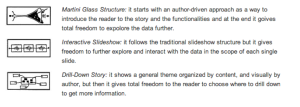Narrative visualisations of the public persona
With my work I want to invite to look at the ‘public persona’ as a set of stories which can be discovered through the idea of the metamorphosis as it can be found everywhere in nature. Metamorphosis describes the transformation of one thing to another, identities, events, ideas or objects can be mapped from one context into another and become a new thing which can co-exists besides the old, leave the old behind or destroys what has been before.
When visualizing data we can contextualize visualisations in a story as a potentially intuitive and fast exploration of very large data ressources.
This story can be very linear and curated by the author as in most traditional media. But it can also be directed and driven be the reader, as often found in digital media.
But which balance between an author driven story and a reader driven story do we need in order to make sense out of publicly available data without being manipulated.
The basis for my work is a text from Edward Segel and Jeffrey Heer of whom you can find a summary here: http://infosthetics.com/archives/2011/01/research_telling_stories_with_data.html
In this text various storytelling techniques are compared in a very structured way. The authors differentiate between Author-and reader driven techniques.
Below you can find some reader driven techniques presented . The Martini glass structure seems to be the most appropriate way to introduce into a topic but letting the user explore data by himself afterwards and so I use it as a starting point.
The question in this case is how we can assure that the user doesn`t only find curated data but can explore new aspects and layers of meanings by combining different aspects of data himself. How can we plan serendipity when crafting data driven stories?
As already said this work focuses on publicly available data which include data about ourselves. Which role do these publicly available data play in todays society and in the globals polis? How can we understand our public persona and its role in the digital global polis?
The polis is a concept which I discovered by reading this book:
http://www.naipublishers.nl/architecture/neurath_e.html
In this book serendipity is analysed as a concept of building cities, driven by culture.
(Side note: The polis is a loose community centered around a city but without clear borders. It is defined by its memebers and not by its geographical boundaries)
As already said I want to invite to this topic with a philosophical discourse borrowed from Ovids Metamorphosis. I want to think about how the public persona can transform within the digital polis and how the users can be introduced to his public persona with stories which allow him to understand a certain complexity in his own data and the big data of the digital polis, the context of his public persona. But at the same time this introduction may not block a certain serendipity and discovery of new aspects.
I want to create case studies with two or three real users in the next weeks (if legally possible) and see wheather the Martini structure as proposed by Segel and Heer is a good way to storify publicly available data or if I can not come up with a better narrative structure.
I will also have a look at visual design elements of narrative visualisations and the beauty of the visualization itself in order to generate ideas on how best publicly available data and the public persona can be explored.
My work consists of a series of experiments and as a result I will present some Hypothesis at the end of my work.
Links:
http://www.ted.com/conversations/3795/our_public_vs_our_private_pers.html
http://infosthetics.com/archives/2011/01/research_telling_stories_with_data.html


